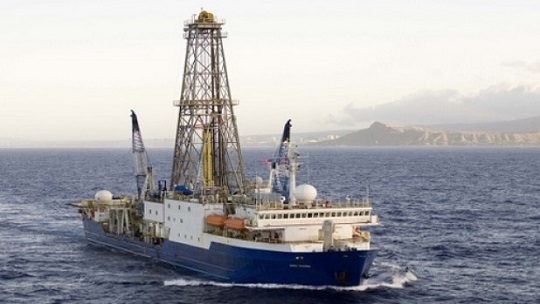Major international study of slow-slip earthquakes to drill off Gisborne
A $10-$20 million project to drill into the seabed off Gisborne aims to significantly improve the understanding of slow-slip earthquakes. SGEES Prof Martha Savage and MSc student Tom Wilson were part of the scientific crew.
Article talen in part from Stuff (Michael Daly, 7 July 2015)

A $10-$20 million project to drill into the seabed off Gisborne aims to significantly improve the understanding of slow-slip earthquakes. SGEES Prof Martha Savage and MSc student Tom Wilson (click here for Tom Wilsons cruise blog) were part of the scientific crew.
Three sites will be drilled up to 1.5km below the seafloor by the International Ocean Discovery Programme (IODP), of which New Zealand is a member. The work has been scheduled for 2018 using the research ship JOIDES Resolution.
About 50 scientists from eight countries were likely to be involved, GNS Science said.
An international research project offshore from Gisborne should provide a big boost to the understanding of slow-slip earthquakes.
"Findings from such a project would have global significance as it has the potential to significantly boost our understanding of the mechanics of subduction zone faults and the earthquakes that occur on them," GNS Science marine geophysicist Stuart Henrys - one of the New Zealand-based leaders of the project - said.
The drilling will be done around the Hikurangi subduction zone where the Pacific tectonic plate is being thrust beneath the Australian plate.
The most easterly of the proposed sites is in sediment on the Pacific plate which will eventually be subducted beneath the North Island. The middle site is slightly to the west of the fault front between the two plates, while the most westerly site - closest to land - is over the Australian plate at a point where the Pacific plate is about 5km down.
The study will be the first undersea drilling project in the world aimed specifically at understanding the mechanisms of so-called silent earthquakes, also known as slow-slip events, which can take weeks or months, compared to just seconds in a normal earthquake.
The slow-slip events off Gisborne have attracted international interest because they are relatively close to the surface - typically about 5km below the seafloor, making them accessible by scientific drilling.
Slow-slip quakes were not felt and did not do any damage but might be precursors to more violent quakes, Henrys said. Another hypothesis was that they relieved stress.
"We really want to know the answer to that."
All the slow-slip events mapped in the area had been below the drill site closest to land - about 40km east of Gisborne - and instruments would be placed at the site to measure such events.
Instruments placed at the middle drill site should show whether slow-slip events were also happening at places where the Pacific plate was at shallower depths below the Australian plate.
"Further down the track we want to drill right into the region experiencing those slow slips... We eventually want to drill all the way down to that plate boundary 5km deep," Henrys said.
A really big earthquake would not happen close to the Hikurangi Trench.
"If it erupts it will be closer to land, so we want to drill closer to land to understand what's happening there," he said.
"That requires an even bigger drill rig." If that project were to go ahead it could be 10 years away.
There was a distinct boundary on the seafloor between the plates although most of the time it was somewhat masked by sediment.
"But if there's an earthquake and it ruptured, you would be able to go down and put your finger on it," Henrys said.
Other proposals using the drill rig that would be here in the 2018 were being considered for international funding.
They included drilling into a volcano in the Kermadec Arc, drilling in the Tasman Sea and drilling in the Ross Sea for climate research.
The aim of the Tasman Sea proposal was to look at the start of the subduction process. The site for that research was to the west of the country because the boundary between the Pacific and Australian plates came into being maybe 30-40 million years ago when New Zealand was closer to the continent of Australia.
"We're trying to get a handle on how that process initiates and how it evolves in time," Henrys said.
"We're trying to really figure out how the planet functions."
These were exciting times. "It's unbelievably exciting, incredible."
Because this country was a member of the IODP there was an opportunity for New Zealanders to be in leadership positions for the work being done here. It was also hoped students and young scientists would be on board the drill ship.
"We need a pool of earth scientists in this country excited about the hazards and resources," Henrys said.
In other work already under way, Instruments left on the seafloor offshore from Gisborne and retrieved after 12 months had recorded a large slow-slip event of about magnitude-6.8 last October and November.
While it was still early days it looked as if the instruments had captured some interesting information.
